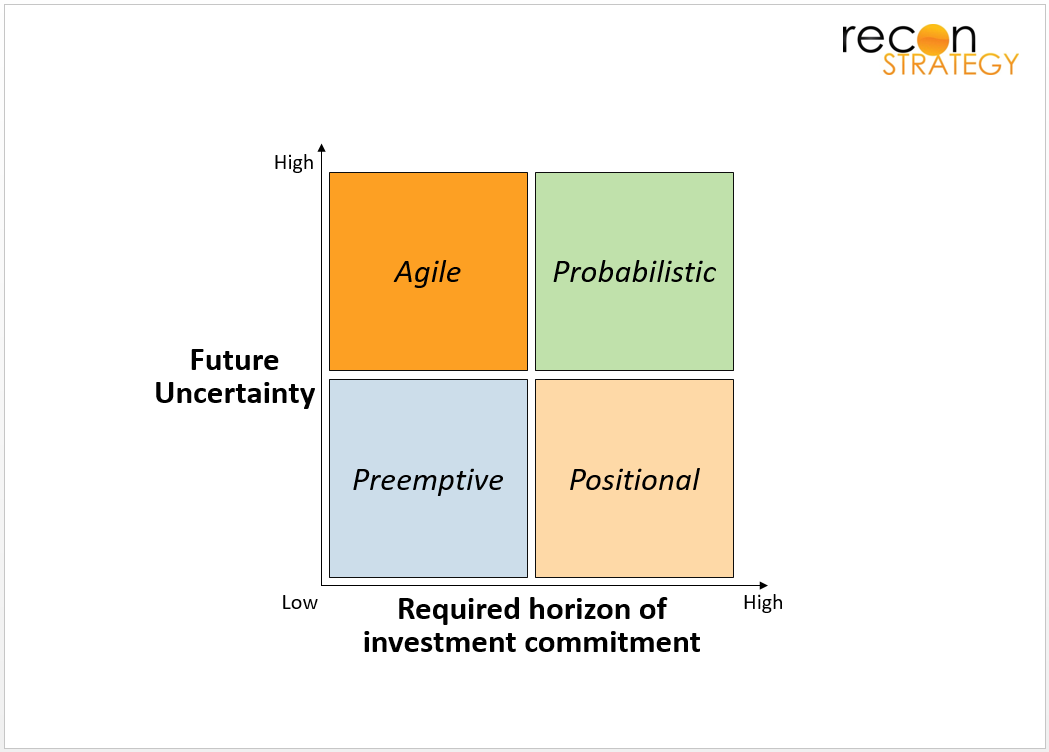“Agile corporate strategy” (as defined in a previous post) is already the established the weapon of choice for small, early-stage innovators trying to re-invent their marketplace, where the product is the company and uncertainty is the hallmark new emerging markets. Startups like agile strategies – often referred to a “Lean Startup” – because they effectively counter the scale advantage of incumbent competitors without requiring massive initial investment. But contrary to the conventional wisdom that firms must abandon agility as they get larger and more complex, in the right market context an agile business unit or corporate strategy remains a useful option for established business units and companies as well.
But context is critical. Unlike agile delivery methods that improve operational effectiveness in almost all strategic contexts, an Agile Strategy is extremely beneficial in contexts where maintaining optionality is important, but potentially disastrous in ones that require significant commitment to a single view of the future. To determine when an Agile Corporate Strategy makes sense, it is important to understand the strategic context landscape outlined in figure 1 below.
Figure 1: The strategy context landscape
The strategic context framework segments the world of competitive landscapes based on two dimensions: “How certain or uncertain is the future state of the industry?” and “How long in advance do we need to commit investments to a given direction?” In this world, we define four different strategic “zones” with different optimal strategies:
- The Positional zone defines market contexts with high predictability and long investment horizons, where competitors can establish and defend static strategic positions over many years. This typically includes heavy industrial markets like mining with multi-billion dollar investments and global dynamics played out over relatively predictable decade-long business cycles. You would not want to use an agile strategy in this context, because maintaining optionality would preclude making the big committed investments in the future that are needed to succeed in this competitive zone.
- The Preemptive strategy zone includes contexts with high predictability and short investment lead times, where competitors jockey to beat each other to a set of predictably evolving strategic positions. In healthcare, this would include examples like competition between urgent care networks or retail clinics to grab the most desirable locations, or the rush to lock-in the most desirable technology partner alliances. With little future uncertainty relative to the investment horizon, preserving future optionality generally isn’t worth the additional cost to do it.
- The Probabilistic zone includes contexts with high unpredictability, but also long investment horizons. These are “big bet” markets where the best you can do is make educated guesses based on good statistics, hope things work out, and perhaps hedge your bets a little. Because of enormous investments in highly uncertain drug pipelines, the Biopharma industry behaves much more probabilistically than most Pharma executives would probably prefer. Although long investment horizons generally preclude using full agile strategy in this zone, companies can often use agile thinking to discontinue investments (and cut losses) in bets that aren’t going to pan out. Also, many companies that thought their industry required big bets in the future have been able to use agile delivery methods and process re-engineering to break big bets into a series of smaller incremental bets and pull their firm into the “Agile” strategic zone.
- Finally, the Agile region covers markets with high unpredictability and shorter investment horizon and includes most new industries, heavily consumer-driven industries, or markets going through significant restructuring or dislocation. Clearly, an Agile strategy is ideal for this region, where a competitor must respond to uncertainly evolving market conditions and can make some or most investments incrementally to maintain strategic flexibility.
The reason we are digging deeper into Agile Strategy on the Recon blog is because many areas within healthcare are increasingly in the “Agile” zone due to shifting regulatory environments, and patients who increasingly expect healthcare experiences that resemble those in consumer markets. The rise of new technological capabilities is also dramatically shortening the required investment horizon for many “Probabilistic” region competitors and pulling them into the “Agile” zone. These mature companies in newly-emergent competitive zones should seriously consider Agile Strategy as part of their strategic toolkit.

